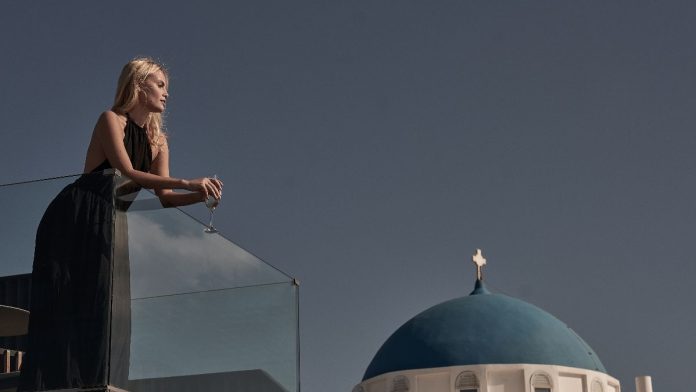The bizarre hotel on Greece’s most famous island offers a real taste of the country.
After years as a journalist and even longer as a travel obsessive, I’m rarely blown away by a spot – but Kivotos Hotel in Santorini did just that.
I’ve spent a protracted time in Greece over time, from the Peloponnese to barely touched places within the Saronic Islands.
By some means, I hadn’t made it to arguably the country’s most famous place. Now I actually have, I can only say how glad I’m.
Santorini is all the pieces you’d imagine – all white-washed buildings with cyan blue accents, surrounded by perfect magenta bougainvillaea.
Kivotos looks somewhat different.
The second branch after Mykonos, the Santorini enterprise was opened by the Michopoulos family five years ago – and it stands out from the remainder of the buildings within the picturesque village of Imerovigli, within the easiest way.
Even though it offers the sunset views made so famous by postcards and trending videos on TikTok, Kivotos is, unlike every constructing in its vicinity, painted black.
Walking up and down the seemingly infinite narrow stairs along the cliff, it’s hard to miss – and that’s even before you’ve stepped contained in the gates.
Inside, the suites and villas are truly a wonder to behold and so they stand out just as much because the black exterior.
A tribute to Santorini’s volcanic landscape
I arrive after dark originally of September after taking only a transient glance at Kivotos’ Instagram. Really, I had no idea what to anticipate, but walking right into a recreation of a volcano was not it.
This unique experience, the hotel’s charming welcome team told me, is a tribute to the island itself and its very wealthy history.
Santorini was devastated by a volcanic eruption within the sixteenth century, which without end shaped its rugged – and now legendary – landscape.
In the next centuries, locals made probably the most of the incident, constructing towns and villages which cling to the cliffs. The black sand beaches below are surrounded by caves.
My suite at Kivotos could be very much inspired by a cave formation, with wide, curved ceilings – and the lighting is solely remarkable.
I can safely say I actually have never entered a hotel room to be enveloped by red throughout. After I express my surprise, I’m told the suites were designed to make visitors feel as in the event that they were staying inside a volcanic cave, an experience harking back to the Santorini of centuries ago.
After settling in – and understanding it’s entirely possible to vary the lighting to any shade I desired – I step outside my door to soak up the famous Santorini vista. It’s still spectacular even within the darkness, because of the clearness of the skies showing off a large number of stars.
Taking a glass of locally-made wine into my personal Jacuzzi, I then luxuriate until my skin turns prune-like.
Sample fish prepared with Santorini’s volcanic ash
Despite the pure joy of that have, it’s on to the duty at hand.
I’mhere, mostly, to learn in regards to the culinary richness of Santorini via the hotel’s own restaurant, MAVRO.
The eatery itself is impressive enough, with a glass terrace high on the cliff with probably the most stunning view of that famous sunset.
But then comes the food, the brainchild of a team led by Dimitris Katrivesis, the restaurant’s head chef.
At its core, he tells me, the extensive, impressive menus “began as a strategy to have a good time the incredible flavours of Santorini and showcase a recent high quality dining experience for guests on the island”.
It goes deeper than a celebration of the island though, with every dish served paying tribute to Santorini’s very make-up.
The delectable Fossilised Shrimp draws its inspiration from the numerous caves, where ancient fossilised creatures were once discovered. “We’ve captured that essence on this dish, bringing the past to life in your plate,” Dimitris explains of the exquisite shrimp dish.
Going further still, the Haiboshi Mackerel is paired with local, white aubergine and miso.
I learn that the mackerel, which complements the opposite flavours oh so perfectly, is definitely prepared using a way which involves Santorini’s volcanic ash.
To me, that’s genius; to Dimitris it’s nothing more complicated than “adding a subtle depth that evokes the island’s volcanic landscape”.
While the Cyclades islands are world-famous for his or her fish dishes, freshly harvested olive oil and salt straight from the Aegean sea are must-tries, too.
Dimitris combines those treasures right into a luscious pudding – the Aegean Sea Salt Ice Cream.
Drizzled with olive oil and topped with caramelised pine nuts, it makes for the proper combination of salty, sweet and creamy -“a refreshing tribute to the flavours of the Cyclades”, Dimitris says.
Digging in, it definitely seems to me as if I get an actual taste of the island group – and that’s something Dimitris is thrilled about.
“I’m proud to say that about 70 per cent of our ingredients come from Santorini and the encompassing Cyclades. Sourcing locally is incredibly essential to us,” he tells me. “It allows us to support the area people and ensure our dishes are fresh and stuffed with flavour.
“Using seasonal ingredients allows us to create unique and authentic dishes that genuinely reflect the spirit of the island.”
Could Santorini grow to be the gastronomic capital of Greece?
While I challenge you to seek out anyone who doesn’t like Greek food, Santorini shouldn’t be referred to as the gastronomic capital of the country – yet.
While the northern port city of Thessaloniki officially took that title earlier this 12 months, when UNESCO designated it as a city of gastronomy, Dimitris is confident Santorini can follow in its footsteps.
“I think Santorini has the potential to grow to be the culinary hotspot within the Cyclades. The island is blessed with delicious produce, equivalent to its renowned tomatoes, fava beans and exceptional wines,” he tells me. “These ingredients not only have a definite flavour but additionally reflect the wealthy agricultural heritage of the region.”
Along with his team, he says he’s pushing the boundaries of traditional Greek cuisine, with the hope of allowing Santorini to “shine even brighter on the culinary map”.
Dimitris adds that he desires to take his guests on a foodie journey which is “not nearly dining, but about connecting with the island’s culture”.
As I head back to my glorious suite and straight back into the Jacuzzi – I’m a water sign, don’t blame me – I treat myself to 1 last glass of the luxurious local wine.
At this moment, I understand exactly what Dimitiris had been saying – MAVRO really is a taste of Santorini itself, and one I’m itching to try again.
Unlock the world’s wonders with unforgettable journeys tailored just for you! Whether you crave sun-kissed beaches, thrilling adventures, or rich cultural escapes, your dream destination awaits. Enjoy seamless travel with expert tips, exclusive deals, and handpicked experiences that Turn Every Trip into a lifetime memory.










